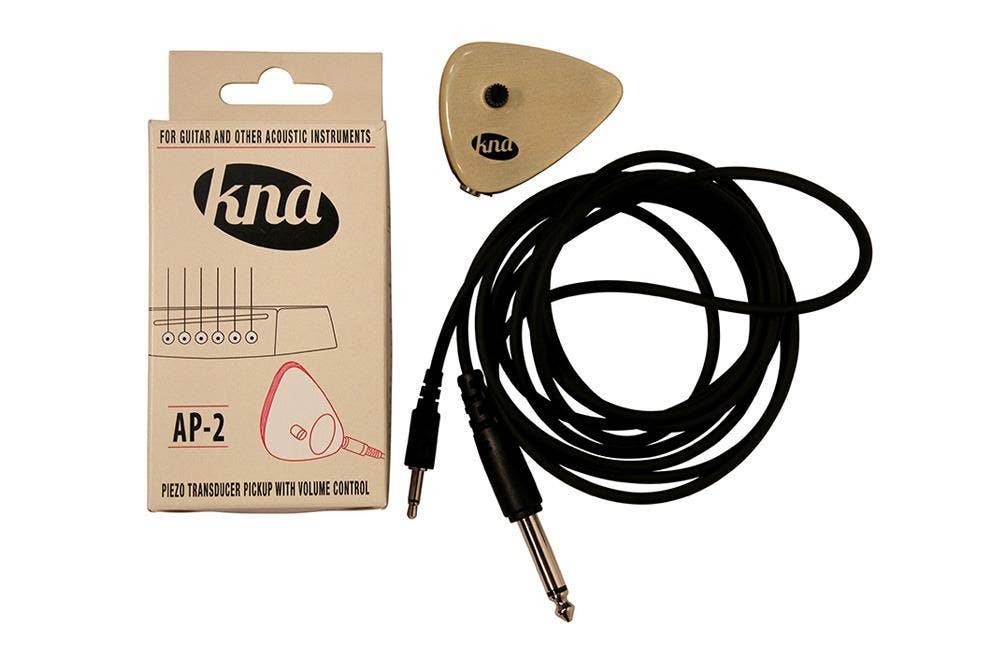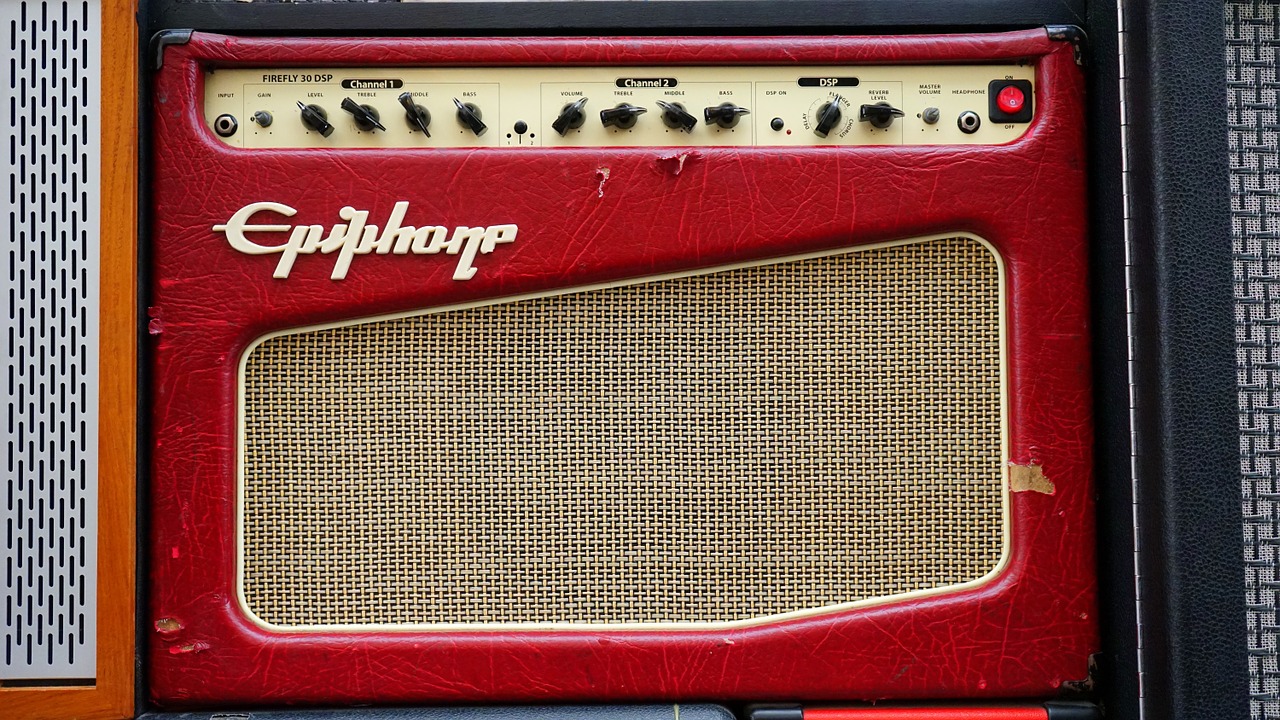I often find that when playing my mountain dulcimer, I produce more than enough volume in a small setting. But for larger venues, the dulcimer sometimes struggles to be heard. That is where amplification can help. In this article, we’ll discuss what amplification is as well as some of most common ways to amplify a dulcimer. We’ll also discuss the pros and cons of each.
These methods are relevant to both mountain and hammered dulcimers.
How Does Amplification Work?
When a player plucks a string on a dulcimer (or any acoustic instrument for that matter), the string vibrates at a certain frequency. The resulting vibration is transferred to the body of the instrument through the bridge, causing the body to vibrate at the same frequency. These vibrations compress and expand the air inside the body of the dulcimer. And this is what our ears pick up as sound waves. In a sense, the body naturally “amplifies” the sound of the strings.
Electric amplification takes this one step forward. Here, a device “picks up” the string’s vibrations (or the vibrations of the wood, which we’ll discuss later) and transforms these vibrations into electrical signals which have the same frequency. These electric signals are then sent through a wire to an amplifier, and ultimately to a speaker.
The speaker flips this process around by vibrating at the same frequency as the electrical signals. As a result, the speaker produces sound waves that we can hear.
Using Microphones to Amplify a Dulcimer
For many, the use of small high quality microphones is the cheapest and easiest way to amplify a dulcimer. This method often results in the most faithful reproduction of sound for an acoustic instrument.
Advantages of Microphones
A microphone will capture all the sounds a listener would hear when sitting near an instrument. One of the pros of using microphones is their simplicity. Either attach a microphone to a stand and position it near the dulcimer, or attach a microphone to the body itself.
Another advantage to microphones is that they can capture reverberations which add richness to the tones. In addition to picking up sounds from an instrument, the human ear also picks up reflected sound.
These reverberations (commonly referred to “reverb”) are the result of sound that bounces off walls, reaching the ear micro-seconds after the original sound. Combined with the original sound, these delayed sound waves result in a fuller tone that is rich in overtones.
Disadvantages of Microphones
While microphones are a great way to amplify a dulcimer, they do have some drawbacks. To start, many microphones are designed to pick up sounds within a close range – ie, within a few inches – while ignoring any ambient noises surrounding the instrument. This is called a proximity effect. While this is incredibly useful in a live setting, it does require the performer to maintain roughly the same distance to the microphone.
Hammered dulcimers players typically mount the instrument on a stand or platform, and so this is not generally an issue. Mountain dulcimer performers often play while seated, but can shift around which can cause an issue. Players of a dulcimer guitar, however, may also need to move around.
When moving in and out of the mic’s proximity, drop-outs can occur as the player moves out of the microphone’s range. You can compensate for this by using a microphone that picks up sound over a wider area. However, you risk picking up crowd noise and other ambient sounds.
Since the dulcimer is generally a quiet instrument, microphones need to be placed fairly close to the body. If the microphone is not close enough, you can increase the volume or gain but this could end up decreasing the proximity effect. However, the microphone may pick up sound over a wider area, which can ultimately cause feedback.
We’ve all heard feedback before, but what is it exactly? Quite simply, feedback occurs when the microphone picks up the sound of the speakers and “feeds it back” through the amplifier where it is again amplified and sent through the speakers. Feedback is something I try to avoid at all costs during a live performance!
Dulcimer players can simply connect the microphone to a stand-alone amplifier using the supplied cable or patch cord. In some instances you may need to use an adapter to convert the cable to the standard ¼” input size used by most amplifiers.
Recommended Dulcimer Microphones
A quick, but effective solution to amplify a dulcimer is to simply point a standard dynamic microphone like a Shure SM 57 or Shure SM 58 at the dulcimer from above. Hook it in to whatever sound system is available and you’re in business.
Shure SM57 Microphone

A friend of mine who plays the hammered dulcimer in small groups onstage swears by a little microphone called the DPA d:vote 4099G. Here, DPA refers to Danish Professional Audio. This particular microphone is well suited to the hammered dulcimer, but works well with a mountain dulcimer as well.
Simply set the microphone in its holder, attach the unit to the side of the dulcimer, and point it across the soundboard. This model is expensive, but it faithfully picks up every nuance of what the dulcimer is capable of and delivers exceptionally clean sound.
DPA d:vote 4099 Microphone

For those looking for more affordable options, another option I’ve seen work is the Audio Technica 2035. This is an excellent, studio quality condenser microphone. Its large diaphragm will result in smooth, natural sound, with low noise. This model also comes with a custom shock mount. Condenser microphones are generally more sensitive than dynamic microphones. And the AT 2035 will pick up your dulcimer playing very clearly.
Audio Technica 2035 Microphone

Note that condenser microphones typically require power from the sound system – sometimes referred to as “phantom power”. Most sound systems have this ability. However, smaller free standing amplifiers may not. In his case, purchase an inexpensive battery powered box to put in line between the microphone and the amplifier to supply the power.
Using Piezo Pickups to Amplify a Dulcimer
Another approach to amplification is to use a piezo pickup. A piezo pickup is basically a small, lightweight metal disc that is attached to another metal disc (of a different type of metal). A piezo pickup works by sensing vibrations and then converting them into a corresponding frequency. When attached to a dulcimer, it picks up the vibrations of the wood and transmits these frequencies via a small electric current.
Advantages of Piezo Pickups
There are many advantages to using piezo pickups. Since piezo pickup sense wood vibrations (as opposed to string vibrations), many musicians feel that these devices reproduce tones that are closer to the natural sound of the instrument. Some musicians even characterize this is a “woody” tone.
One of the nice things about piezo pickups is that, unlike microphones, they do not pickup ambient noises. You only hear the sound of the instrument. Also unlike microphones, feedback is also not typically a problem with piezo pickups. That said, I noticed that you can experience minor feedback at very high volumes. Because of their small size, they are also unobtrusive in appearance – particularly when hidden inside the instrument. This is something I value, given the dulcimer’s natural beauty.
You can attach piezo pickups to the instrument in many places, such as to the underside of the instrument’s soundboard or placed under the bridge. Sometime you can find them as part of clip-on pickups. Some musicians just buy the piezo elements (which are inexpensive), and glue them to the underside of their soundboard in several different location. Once attached, you can wire the piezo pickups to a simple output jack.
Disadvantages of Piezo Pickups
A drawback to this approach is that the pickups will need some type of active (battery powered) control box to run through prior to sending the signal to the sound system. While control boxes are readily available in music stores and online, they can get pricey.
Hammered dulcimer players take note. In some instances, piezo systems can pick up hammer noise strongly. Furthermore, if the pick up elements are attached to the sound board, the hammer noise can be very noticeable and distracting.
Piezo pickups generally use the same standard 1/4″ connectors that are used on other instruments. Some dulcimer players I know prefer using a pre-amp with a piezo pickup to increase power output. However, I’ve never needed one. Unless you want a lot of volume, simply plug the dulcimer into a stand-alone acoustic amplifier. That should be sufficient for most purposes.
The use of piezo pickups is a great all-around was to amplify a dulcimer. Since it accurately reproduces the actual tone of the dulcimer, the sound is superior to that from magnetic pickups (as discussed below). And plus, piezo pickups are unobtrusive and don’t detract from the beauty of the instrument. Unless it is plugged in, it’s hard to even notice whether it is amplified at all!
Recommended Dulcimer Pickups
One of the most popular pickups used by dulcimer musicians is the Myers pickups. This is a highly versatile pickup that can be used for multiple acoustic instruments, in addition to the dulcimer. It is currently the smallest all-in-one active/preamp pickup available in the market today.
Myers Mountain Dulcimer Pickup

The Myers Mountain Dulcimer Pickup comes fully equipped with an internally powered, active preamp which produces exceptionally rich sound. Each pickup comes complete with volume control as well. All hardware is included for 3 mounting options, including low-impact adhesive backing for placing on the dulcimer’s soundboard.
Myers is also a US-based company with a reputation for excellent customer service. Customer reviews for Myer pickups are excellent across the board.
Check out the video below which demonstrates the Myers pickup in action by renowned dulcimer player Kevin Roth. This shows optimal pickup placement as well as how these pickups amplify sound in public venues.
Please support fellow dulcimer players like Kevin by liking this video!
Another pickup we’ve seen on some mountain dulcimer setups is the KNA AP-2 Piezo Acoustic Pickup. This is a more affordable option that the Myers pickup, and can be purchased for around $50. If you’re dipping into amplification for the first time, this may be a smart place to start.
KNA AP-2 Piezo Dulcimer Pickup

Made in Europe, the AP-2 is ideal for dulcimer players looking for an easy, effective solution to amplify their instrument. Like the Myers pickup, the KNA also comes with control volume. The pickup and volume control are housed in a handsome wooden case which attaches safely to the soundboard using PowerTack adhesive. A 1/8″ to 1/4″ cable allows the pickup to remain in place while in storage.
Using Magnetic Pickups to Amplify a Dulcimer
The last method to amplify a dulcimer is to use a magnetic pickup. Most dulcimer players prefer using either a microphone or piezo pickups for amplification. While the use of magnetic pickups is not common for hollow body dulcimers, it’s worth reviewing how they can be used.
Like piezo pickups, magnetic pickups sense the vibrations in the dulcimer and convert them into electrical currents. If you open up a magnetic pickup, you will notice that it is essentially a magnet that is wrapped with a copper wire coil. The vibrations of the metal strings affects the coil, and a small current is created in the pickup which is then sent to an amplifier.
Many things can affect the tone produced by a magnetic pickup, including the specific kind of magnet, the wire diameter, how many times the wire is would around the coil, etc. Generally speaking, most solid body instruments (ie, electric guitars) and some acoustic instruments use magnetic pickups.
A magnetic pickup can be attached to a dulcimer in several ways. The most common way is to attach it to the surface of the soundboard by using removable adhesive. Another, more intrusive, way is to build the pickup directly under the bridge of the instrument. Like other amplification options, magnetic pickups typically use a cable with 1/4″ connectors or plugs.
Advantages of Magnetic Pickups
Like piezo pickups, magnetic pickups only pick up the instrument’s vibrations and are unaffected by ambient noise. This substantially reduces the possibility for feedback, although it can occur at very high volumes. That said, magnetic pickups are not ideal for acoustic instruments for several reasons.
Disadvantages of Magnetic Pickups
First, the sound produced can be quite different than that of the actual instrument. It’s quite easy to tell the difference in sound between an electric and acoustic guitar.
Second, magnetic pickups can add significant weight to the dulcimer. This is due to the large magnet, copper wire coils, and other materials and wiring. To make matters worse, magnetic pickups often come with volume and tone controls which add even more sound-dampening weight.
Third, magnetic pickups can severely decrease the sound quality of an acoustic instrument by dampening the vibrations on the top of the instrument. This is particularly true for the dulcimer since most of the tone is produced by the top of the soundboard. This is true even when not plugged in. Unless a magnetic pickup is attached with adhesive and removable, a permanently attached pickup will have a negative impact on the dulcimer’s natural acoustics even when not in use.
Finally, magnetic pickups detract from the dulcimer’s appearance. I mean, who really wants a large black plastic device screwed into the body of a dulcimer when other options exist?
Magnetic pickups are often preferred when amplifying solid body dulcimers and guitars. But for most hollow body mountain and hammered dulcimers, piezo pickups or microphones work best for most musicians.
Choosing an Amplifier for a Dulcimer
Once you’ve determined the best input method for amplifying your dulcimer (microphone or pickup), you’d need an output system such as an amplifier.
An electric guitar amplifier will generally work fine for your dulcimer. However, these types of amplifiers are designed to modify the instrument’s sound and increase volume. For a dulcimer, an electric guitar amplifier is probably not your best choice. In contract, acoustic amplifier produces very realistic sounds and are the preferred choice for dulcimer players. There are a wide variety of acoustic amplifiers available, and some are even battery powered – super handy for playing outdoors.
Interesting in learning more? Check out our article that reviews the best acoustic amplifiers for your dulcimer.
Final Thoughts on How to Amplify a Dulcimer
Unless you’re performing in a public venue, odds are you may not need to amplify your mountain or hammered dulcimer. After all, the soft sounds of a dulcimer are what attracts many to the instrument in the first place.
But if you find yourself competing to be heard, amplification may be necessary. The easiest solution is to purchase a microphone – either mounted on a stand above the dulcimer or directly on the instrument. While this is the least invasive option, microphones are prone to picking up ambient noise and can result in feedback if not careful.
Piezo pickup systems help address these drawbacks but require careful placement on the dulcimer, and may result in slight modifications to the instrument to accommodate a standard jack.
In the end it may be helpful to seek advice from a local dulcimer club, teacher, or music store. But as is often the case, much comes down to musician preference.




